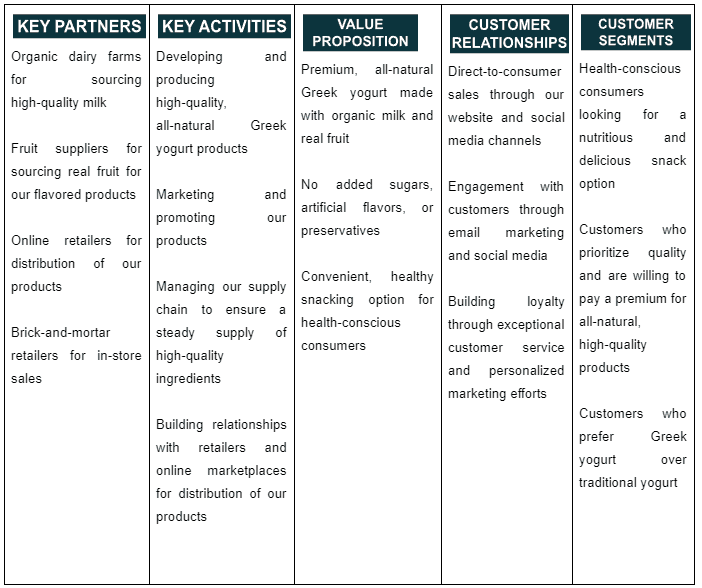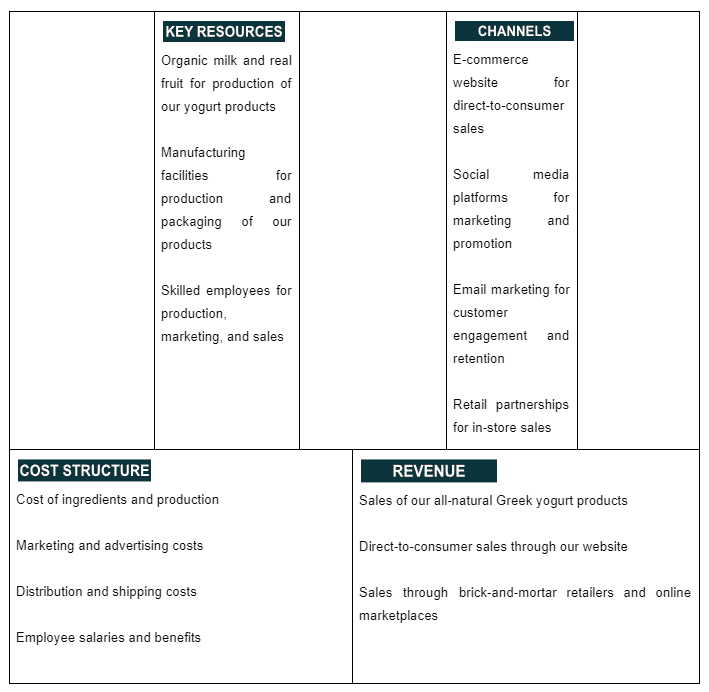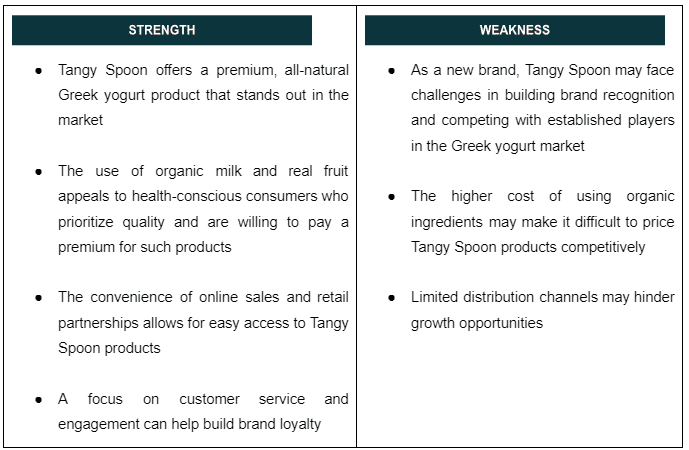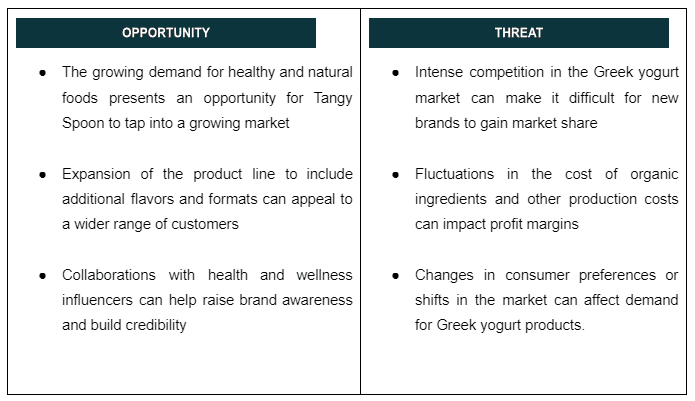Written by Elma Steven | Updated on May, 2024

Executive Summary
Overview: Tangy Spoon is a premium Greek yogurt brand that aims to revolutionize the industry by providing customers with a healthier and more delicious alternative to traditional yogurt. Our products will be made with high-quality ingredients including organic milk and real fruit, and will be available in a variety of flavors to appeal to a wide range of tastes. We will initially focus on selling our products online and through select retail partnerships, with plans to expand our distribution as we grow. Our goal is to become the go-to brand for consumers who want a tasty and nutritious snack that they can feel good about.
Mission: Our mission is to provide customers with a delicious and healthy alternative to traditional yogurt by offering premium, all-natural product made with organic milk and real fruit. We aim to promote the importance of choosing high-quality, nutritious foods and to make healthy snacking convenient and accessible for everyone.
Vision: Our vision is to become the leading brand in the Greek yogurt industry by providing customers with the highest quality products, exceptional customer service, and innovative marketing strategies that educate and inspire healthy living.
Industry Overview: The yogurt industry is a large and growing market, with an estimated value of $81.7 billion in 2020. Greek yogurt, in particular, has experienced significant growth in recent years, with sales increasing by 4.4% annually from 2015 to 2019. This growth is expected to continue, with the Greek yogurt market projected to reach $7.3 billion by 2027. Health-conscious consumers are driving demand for Greek yogurt, which is perceived as a healthier and more nutritious alternative to traditional yogurt. However, many Greek yogurt brands on the market today are heavily processed and contain added sugars and artificial flavors. This has created an opportunity for a high-quality, all-natural Greek yogurt brand like Tangy Spoon to stand out in the market.
Check out this guide on how to write an executive summary? If you don’t have the time to write on then you can use this custom Executive Summary Writer to save Hrs. of your precious time.
Financial Overview:
Business Description
Business Name: Tangy Spoon
Founder: Jacob Harrison
Management Team:

Legal Structure: LLC
Location: 1234 Main St, Bellevue, WA 98004
Goals:
- To establish Tangy Spoon as a recognizable and trusted brand in the Greek yogurt industry
- To expand our product line to include a wider range of flavors and formats, such as drinkable yogurts and yogurt cups
- To build a loyal customer base through exceptional customer service and engagement
- To increase our distribution channels and expand our retail partnerships
- To contribute to a healthier and more sustainable food industry by using organic ingredients and reducing our environmental footprint
Products:
Tangy Spoon will sell a range of natural Greek yogurt goods, such as plain yogurt cups, yogurt that you can drink, and fruit-flavored yogurts. Our goods won’t have any added tastes, colors, or chemicals and will be made with organic milk. Our choices will be varied so that everyone can find something they like. There will be basic flavors like strawberry and blueberry, as well as more unusual ones like honey and fig. We plan to add yogurt cups and other new forms that give customers easy and healthy eating options to our product line in the future.
Financial Overview
Fund Usage Plan
KPI
| Liquidity | 2020A | 2021A | 2022F | 2023F | 2024F |
| Current ratio | 6 | 12 | 23 | 32 | 42 |
| Quick ratio | 6 | 11 | 22 | 31 | 40 |
| DSO | 8 | 8 | 8 | 8 | 8 |
| Solvency | |||||
| Interest coverage ratio | 8.2 | 11.1 | 14.2 | ||
| Debt to asset ratio | 0.01 | 0.01 | 0.2 | 0.18 | 0.16 |
| Profitability | |||||
| Gross profit margin | 51% | 51% | 53% | 53% | 53% |
| EBITDA margin | 12% | 14% | 21% | 22% | 22% |
| Return on asset | 5% | 6% | 13% | 14% | 14% |
| Return on equity | 5% | 6% | 16% | 17% | 17% |
Business Model
Check out the 100 samples of business model canvas.


SWOT
Check out the 100 SWOT Samples


Organizational Overview
Founder

Jacob Harrison
Founder/ CEO/ Jacob Harrison
Hey there! I’m the founder of Tangy Spoon, an upscale Greek yogurt brand that wants to give people a healthy and tastier lunch choice. My name is Jacob Harrison. I’ve always been interested in food and nutrition, and I saw a chance to make a brand that fits with my beliefs and my goal of making the food business healthy.
Before starting Tangy Spoon, I worked in the food business for more than ten years and learned a lot about marketing, developing new products, and managing the supply chain. I went to a top university and got a degree in food science and nutrition. There, I learned a lot about how different foods affect your health.
As the founder of Tangy Spoon, I promise that my products will only contain the best ingredients and that I will always promote food choices that are good for you and the environment. I think that Tangy Spoon can make a difference in the lives of its customers and the community as a whole by giving them a tasty and healthy snack choice.
It’s one of my favorite things to do to see new places and try new foods from around the world. I like to go climbing and be outside in my free time.
Organogram
Salaries
Management & Operations:
Marketing & Sales:
Finance & Accounting:
Industry Analysis

Source: Mordor Intelligence
Industry Problems
- Many consumers are still unaware of the health benefits of Greek yogurt (ibisworld)
- Greek yogurt brands on the market today are heavily processed and contain added sugars and artificial flavors
- The cost of organic ingredients can be prohibitive for some brands
- Limited distribution channels can make it difficult for smaller brands to reach a wider audience (Gitnux).
Industry Opportunities
- Growing demand for natural and healthy foods
- Expansion of the Greek yogurt market, particularly for premium, all-natural products
- Collaboration opportunities with health and wellness influencers to promote the benefits of Greek yogurt
- Development of new flavors and formats to appeal to a wider range of customers
- An estimated 44.55% of the world’s yogurt sales in 2022 came from the Asia-Pacific region. People mostly buy yogurt through the off-trade route. It is thought that the market will grow by 10.68% between 2022 and 2023 (transparencymarketresearch). The rise can be explained by the fact that a lot of different yogurts are easy to find in stores and food service outlets. An impressive 61.43% of the off-trade segment’s value comes from supermarkets. Many well-known stores, like Maruetsu, Aldi, Big Bazaar, Woolworths Group, and Aeon Retail, sell a lot of yogurt, both foreign and made in Japan. This is why they have the biggest share (Fortune Business Insights).
- Many yogurt types made the world yogurt delivery route grow by 4.57 percent in 2022 compared to 2021. Similarly, stores sell a lot of different kinds of yogurt. In 2021, 8% of people in the United States, which has the biggest yogurt market in North America, chose strawberry-flavored yogurt. Vanilla and blueberry ($4% each), peach ($3%), and mango ($2%) were the next most popular flavors (data bridge market research).

Market Segmentation
- Demographic Segmentation:
- Health-conscious consumers who prioritize natural and organic products
- Customers who are willing to pay a premium for high-quality, all-natural Greek yogurt products
- Customers who prefer Greek yogurt over traditional yogurt
- Psychographic Segmentation:
- Customers who value healthy snacking options and prioritize their health and wellness
- Customers who are environmentally conscious and prefer products made with sustainable and organic ingredients
- Customers who are foodies and enjoy trying new and unique flavors and products
- Behavioral Segmentation:
- Customers who regularly purchase yogurt products and are open to trying new brands and flavors
- Customers who prioritize convenience and prefer to purchase products online or through retail partnerships
- Customers who are brand loyal and seek out products that align with their values and beliefs.
Market Size
Marketing Plan
Marketing Budget
Marketing Objectives
- Boost brand awareness: Increase recognition and recall by 20% within 12 months using targeted campaigns and social media.
- Grow market share: Expand market share by 10% in two years with innovative products and new segments.
- Retain customers: Raise repeat customer rate by 15% within a year through personalization, loyalty programs, and customer support.
- Enhance online presence: Increase website traffic by 25% and social media followers by 30% in 18 months using engaging content and SEO.
- Increase sales revenue: Achieve a 20% revenue growth in the next financial year with promotional strategies and product expansion.
- Strengthen brand loyalty: Improve net promoter score (NPS) by 10 points in 12 months by focusing on customer satisfaction and loyalty benefits.
- Promote sustainability: Increase eco-friendly products by 30% in two years to appeal to environmentally conscious consumers.
- Improve customer engagement: Boost email open rates by 20% and click-through rates by 15% in a year with targeted email campaigns.
- Enter new markets: Launch products in two international markets within 24 months using market research and strategic partnerships.
- Enhance product positioning: Raise top-of-mind awareness as a leader in comfort and innovation within 18 months through marketing and product innovation.
Go-to-Market (GTM) Strategy
- Social Media Marketing:
a. Create and share engaging content that reflects the brand’s values and showcases products.
b. Collaborate with influencers who resonate with your target audience to increase reach and brand awareness.
c. Utilize paid advertising campaigns on platforms like Instagram, Facebook, and Pinterest to target specific customer segments.
d. Engage with followers, respond to comments, and address customer inquiries to strengthen customer relationships and loyalty.
- Content Marketing:
a. Develop a blog on the brand’s website featuring educational and informative content about undergarments, trends, and styling tips.
b. Leverage video content on platforms like YouTube to showcase products, share tutorials, and engage with customers.
c. Create infographics or visually appealing content to share on social media platforms and drive website traffic.
- Email Marketing:
a. Build and segment email lists based on customer behavior, preferences, and demographics.
b. Send personalized email campaigns with targeted offers, promotions, and relevant content.
c. Utilize automation tools to nurture leads and encourage repeat purchases.
- Public Relations:
a. Develop press releases and media kits to promote product launches, collaborations, or brand milestones.
b. Cultivate relationships with industry journalists and bloggers to secure coverage in relevant publications.
c. Participate in industry events, trade shows, and fashion weeks to increase brand visibility and networking opportunities.
- Search Engine Marketing (SEM) and Search Engine Optimization (SEO):
a. Optimize website content and structure to improve organic search ranking on search engines like Google.
b. Utilize keyword research and on-page optimization to target relevant search queries.
c. Implement paid search campaigns (Google Ads) to capture high-intent search traffic and drive conversions.
- Affiliate and Influencer Marketing:
a. Develop an affiliate program to incentivize bloggers, influencers, and content creators to promote the brand and products in exchange for a commission on sales.
b. Collaborate with influencers on content creation, product reviews, and giveaways to generate buzz and increase brand exposure.
- Offline Advertising and Promotions:
a. Place ads in print magazines, newspapers, or on billboards that cater to your target audience.
b. Host in-store events, pop-up shops, or fashion shows to create memorable experiences and connect with customers.
Budget allocation across channels:
Financial Plan
Earnings
Liquidity
Income Statement

Cash Flow Statement

Balance Sheet

Revenue Summary

Cost Summary

Salaries

Non- Current Asset Schedule

Related Articles
Small Business Grant for Business Owners in 2024
Business Ideas for Single Mothers in 2024
Business Registration Complete Process in USA
How to Avoid a Business Failure: Create a Successful Business

